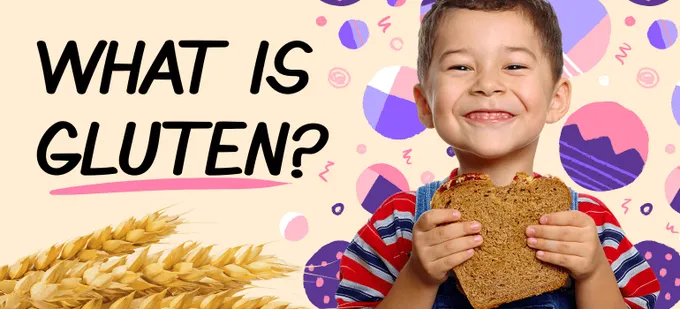Gluten Sensitivity and Celiac Disease in Kids: A Simple Guide
Understand the symptoms and causes behind gluten sensitivity and celiac disease in kids, plus gain valuable dietary tips to manage these conditions.
Updated May 22, 2024

Awareness about gluten and gluten intolerance is increasing as we learn more about kids' nutrition and health. Approximately 1% of people in the United States have celiac disease, but up to an additional 6% of the population may have a non-celiac gluten sensitivity.
Figuring out how your child’s body reacts to gluten and what to do if they have a gluten intolerance can prevent many headaches (literally and figuratively). Here's what you need to know about different gluten intolerances, how they are diagnosed, and how to support your child's sensitive stomach with a gluten-free diet.
» Explore gluten-free solutions to fuel your child's growth
What is Gluten?
Gluten is the major storage protein complex of wheat and makes up approximately 85-90% of the protein content of a wheat kernel (commonly known as a wheat berry). As a protein complex, gluten is made up of hundreds of proteins, but it mainly contains gliadin and glutenin.
» Learn more about the protein needs of infants and toddlers
Sources of Gluten
Gluten is naturally found in wheat, including wheatberries, KAMUT®, Khorasan wheat, einkorn wheat, emmer, durum, semolina, spelt, farina, farro, graham, rye, barley, triticale, malt, brewer’s yeast, and wheat starch. These grains are used in a variety of foods we eat every day.
Foods commonly made with these ingredients include (but are not limited to) bread, pastries, noodles, pasta, baked goods, crackers, cereal, granola, biscuits, waffles and pancakes, panko breadcrumbs, and croutons.
» Try this yummy gluten-free banana protein pancake recipe for sensitive tummies
Gluten is often added to processed foods for many reasons. It is a heat-stabilized ingredient that can act as a binder (holding ingredients together), increase a food’s nutritional value, or add to its bulk. Moreover, not all traces of gluten are obvious—cosmetics (including lip balm), oral care products, supplements, and various medications may also contain traces of gluten.
Foods and condiments that may have added gluten or wheat include soups, sauces, gravies, pre-seasoned and processed meats, meat substitutes made with seitan, salad dressings, marinades, and brown rice syrup.
» Understand key nutrients for kids to help you avoid hidden sources of gluten
Understanding the Body's Response to Gluten Intolerance
Gluten intolerance in kids starts with the inability to fully digest gluten proteins in the digestive tract.
Gliadin and glutenin are rich in the amino acid proline, which makes it difficult for many protein enzymes produced by the stomach, pancreas, and intestines to break down. Gliadin can temporarily increase gut permeability, which isn’t an issue in most people. However, during celiac disease or non-celiac gluten sensitivity, gliadin fragments can pass through the gut barrier and cause inflammation.
» Learn more about food allergies in babies and what you can do about it
Gluten intolerance increases the infiltration of intraepithelial lymphocytes, a type of white blood cell that can infiltrate into the gut barrier. These lymphocytes can trigger both innate immune responses (a general immune response) and/or adaptive immune responses (targeted to specific foreign substances) in the gut. Depending on what kind of gluten intolerance your child has (wheat allergy, celiac disease, or non-celiac gluten sensitivity), the response to gluten will be different.
» Support your child's immunity with nutrition to effectively manage gluten intolerance
Wheat allergies may cause typical allergy symptoms, including difficulty breathing, hives, irritation of the mouth or throat, headaches, and nasal congestion, in addition to gastrointestinal symptoms.
The common symptoms of celiac disease and non-celiac gluten sensitivity are detailed later in this article but include gastrointestinal and extra-intestinal (outside of the gut) symptoms.
» Find out how to safely introduce allergens to your baby to avoid triggering allergy symptoms
Can a Child Grow Out of Gluten Intolerance?
The ability to outgrow gluten intolerance depends on the specific condition.
- Celiac disease is an autoimmune condition that requires a lifelong gluten-free diet and cannot be outgrown.
- For wheat allergy, the majority of children will likely grow out of the allergy by adolescence, but some may have persistent wheat allergies into adulthood.
- Non-celiac gluten sensitivity can be transient and can potentially be outgrown, with doctors recommending a 12-14 month gluten-free diet followed by retesting tolerance to determine if the child has overcome the sensitivity.
Children can potentially outgrow non-celiac gluten sensitivity and some wheat allergies, but celiac disease is a lifelong condition that cannot be outgrown.
» Understand why plant-based toddler nutrition is so healthy and how it can help deal with gluten sensitivity in children
How Do You Know If Your Child Has a Gluten Intolerance?
Symptoms in Infants and Toddlers
Infants and toddlers primarily have gastrointestinal symptoms with gluten intolerances, such as vomiting, abdominal distention, diarrhea with smelly stools, and bloating. Additional symptoms may include poor growth or failure to thrive and irritability.
Symptoms in School-Aged Kids
Young, school-aged children may still have some gastrointestinal symptoms such as diarrhea, constipation, abdominal distention, and stomach pain. These children may also experience dental issues, weight loss, difficulty gaining weight, or short stature.
Symptoms in Adolescents and Teenagers
Adolescents and teenagers may exhibit more symptoms that are related to nutrient deficiencies and growth delays. Common symptoms include weight loss, stunted growth, delayed puberty, chronic fatigue, headaches, skin rashes, mood disorders, and mouth sores.
If your child is exhibiting some of these symptoms after eating certain wheat or gluten-containing foods, then it may be necessary to get a formal assessment of their gluten tolerance.
Wheat allergies are confirmed by skin prick tests for allergies and serum IgE antibodies to wheat allergens, followed by a gluten challenge.
Celiac disease is confirmed by the presence of TG2-specific (transglutaminase 2) autoantibodies and endomysial antibodies (IgA EMA), as well as biopsy results showing villous atrophy within the small intestine.
Anti-gliadin antibody tests can also help confirm celiac disease in individuals with negative TG2-specific antibody tests.
» Help sensitive tummies by offering whole foods to babies and toddlers
What Does It Mean When Your Child Has Celiac Disease?
Celiac disease is an autoimmune condition that causes an immune response to the ingestion of gluten that attacks both gluten and the cells of the intestine. A child can develop celiac disease shortly after introducing gluten into their diet within the first year of life. However, this condition can also manifest at any point during childhood.
» Create a balanced diet for your kid to easily spot celiac disease symptoms after introducing gluten
As mentioned before, gliadin is difficult for our bodies to digest. In the development of celiac disease, gliadin is partially broken down and then transported to the gut mucosa. Once these gluten fragments are there, an enzyme called tissue transglutaminase (TG or TG-2) modifies them so that our immune cells think it is a toxin (or antigen). The body creates antibodies to protect against the gluten fragments, but it also creates autoantibodies against the tissue transglutaminase in our gut mucosa.
Continuing to eat gluten after the immune response can result in long-term damage to the gut. In celiac disease, the adaptive immune response activates and spreads throughout the gut to increase inflammation, malabsorption, and other systemic issues.
» Include healthy fats in your child's diet to help your kids transition to gluten-free foods
Villi, which are the small, finger-like projections on the gut that increase the absorption of nutrients, shrink or flatten in response to this inflammation. This makes it more difficult for the body to absorb nutrients into the body. At the same time, crypt cells, which provide stem cells to renew the epithelial layer of the intestines, generate rapidly in an attempt to make up for villi losses.
» Consider the Paleo diet for kids to help keep your child's sensitive tummy healthy
What Is the Difference Between Celiac Disease and Gluten Sensitivity?
The main difference between celiac disease and gluten sensitivity is the involvement of the immune system.
- Celiac disease is characterized by a specific autoimmune response that causes the body to attack gluten proteins as if they are toxins.
- Non-celiac gluten sensitivity is classically defined as a reaction to gluten in which neither autoimmune nor allergic mechanisms are involved.
However, a 2020 study suggests that non-celiac gluten sensitivity may be caused by a combination of an innate immune response that differs from celiac disease and weakened intestinal permeability. Some symptoms of celiac disease and gluten sensitivity overlap, such as gastrointestinal symptoms of abdominal pain, bloating, and bowel movement abnormalities (diarrhea, constipation). Fatigue may also be a common side effect between the two conditions. However, celiac disease does cause extensive damage to the villi of the intestinal tract and can have the manifestation of other extra-intestinal symptoms.
» Noticing a change in your child’s bowel habits? Find the solution for your toddler's constipation issues
What Causes the Development of Celiac Disease in Children?
The development of celiac disease in children can be attributed to two major categories: genetics and environment.
- Children who carry the genes for HLA-DQ2 or HLA-DQ8 are significantly more likely to develop celiac disease compared to those who don’t. Other genetic factors that influence the development of the protective layer of the intestines and immune system may also impact the risk of celiac disease development.
- Children with type-1 diabetes or other autoimmune conditions, IgA deficiency, a family history of celiac disease, or female gender at birth may also have a greater likelihood of developing celiac disease.
The main environmental factor in celiac disease is the introduction of wheat or gluten into the diet. Introducing it into the diet too early can be a contributing factor to the development of celiac disease. During early infancy, the immune system and gastrointestinal system are still immature and require development to tolerate solid foods.
» Discover key signs baby formula might not best fit for your little one
The introduction of gluten-containing grains within the first three months of life has been associated with a risk of autoantibodies against gluten and wheat. This risk decreases if you wait to introduce gluten-containing foods until at least 4-6 months.
» Learn how to introduce solid foods to your 6+ months old
The American Academy of Pediatricians' current infant feeding guidelines recommend waiting until after 6 months to introduce solid foods to the diet. If your child does have a confirmed HLA-DQ2 or HLA-DQ8 genotype, then it may be beneficial to delay the introduction of gluten into the diet until after your child has reached 5 years old. Other potential triggers of celiac disease include viral infections, tissue damage, and early termination of breastfeeding.
» Explore healthy foods for 8-month-olds, safe for babies with gluten sensitivities
How to Determine If Your Child Has Non-Celiac Gluten Sensitivity
Diagnosis of non-celiac gluten sensitivity (NCGS), also known as non-celiac wheat sensitivity, is somewhat more difficult compared to other gluten intolerance conditions. Your child will have to go through a series of tests to rule out celiac disease and wheat allergy before a diagnosis of NCGS is confirmed.
NCGS tests
Gluten Challenge for Kids
Because the symptoms of irritable bowel syndrome (IBS) and NCGS tend to overlap, a gluten challenge may be needed to confirm a diagnosis, especially if you have not already eliminated gluten from your diet.
In a gluten challenge, your child will follow a gluten-free diet for approximately six to eight weeks. After the gluten-free period, there is an intentional reintroduction of a certain amount of gluten.
If your child has a positive response (reduction of symptoms) during the gluten-free period with a return of symptoms after the reintroduction of gluten, then your child will likely be diagnosed with NCGS.
Gluten challenges are discouraged in children under the age of 5 years or in their pubertal growth spurt. But it still may be recommended in children already following a gluten-free diet in the absence of a formal work-up of celiac disease.
Genetic and Other Tests
Children already following a gluten-free diet without celiac disease diagnosis can receive genetic testing for alleles that show a genetic predisposition for celiac disease.
Other tests can be used to exclude a celiac disease diagnosis and increase the likelihood of being diagnosed with NCGS. Participation in a randomized placebo-controlled trial with gluten can further confirm NCGS.
A diagnosis of NCGS does not rule out the possibility of your child having irritable bowel syndrome due to overlap in FODMAP intolerances.
We currently have an imperfect system to determine NCGS compared to the laboratory markers and tests that can confirm celiac disease and wheat allergy, but it is a good start. Researchers continue to look for specific biological markers that can consistently diagnose NCGS.
» Discover a nutritious, plant-based alternative to the traditional formula, free of gluten, dairy, and soy
What Does Treatment for Celiac Disease Look Like?
Currently, the only available treatment for celiac disease is a gluten-free diet. A gluten-free diet for kids significantly decreases symptoms and can decrease the risk of long-term complications. It may take between 12 to 24 months of a gluten-free diet for a child’s gut to repair itself and alleviate symptoms to improve.
» Learn more about nutritious options for kids on a gluten-free diet
If symptoms of celiac disease do not improve even after following a gluten-free diet for 1 to 2 years, then a gluten contamination elimination diet may be implemented. This elimination diet consists of only fresh fruits, vegetables, meat, and limited condiments.
» Discover nutritious meal ideas suitable for gluten-free diets
If your child has celiac disease, they should be monitored by a gastroenterologist and a registered dietitian to navigate a gluten-free diet. They may also offer an immunosuppressant medication to help moderate the autoimmune response of celiac disease. Because children with celiac disease have damage to the intestinal tract that may decrease the absorption of nutrients, regular monitoring of nutrient levels through lab testing should be done.
» Explore nutritional supplements for children with gastrointestinal problems and failure to thrive
What Foods Can You Give a Child Who Is Gluten Intolerant?
Transitioning to a gluten-free diet when your kid is newly diagnosed with a gluten intolerance can seem overwhelming. But there is actually a lot of variety in this diet for kids. To start, there are food groups (when purchased in their fresh and natural forms) that are inherently gluten-free:
- Meat and poultry
- Beans, legumes, and nuts
- Fish and seafood
- Vegetables
- Fruits
- Dairy
- Else Nutrition products
» Try delicious gluten-free formulas made from almonds, buckwheat, and tapioca
Looking at gluten-free grains for cooking and baking, you also have several options, such as:
- Quinoa
- Millet
- Rice
- Teff
- Amaranth
- Flax
- Tapioca
- Sorghum
- Gluten-free oats
- Nut-based flours
- Corn (as cornmeal, grits, polenta, hominy)
- Buckwheat (despite the name, it doesn’t contain wheat)
Though all of these are gluten-free, you do want to exercise caution with oats. Oats can easily be subject to cross-contamination with gluten-containing grains. If your kid does enjoy eating oatmeal, be sure to purchase a brand that specifically says that it is gluten-free.
» Not sure about rice? Find out if rice cereal is safe for babies and explore these alternatives to rice cereal.
How to Find Gluten-Free Packaged Foods
Packaged foods can be a bit trickier when trying to find gluten-free food for kids, but there are some simple tricks that can make your search easier:
- Food is labeled as gluten-free: The FDA only allows manufacturers to label their foods as “gluten-free” if a serving of the food contains less than 20ppm of gluten.
- Check the allergen listing because wheat is one of the top eight allergens in the United States; the FDA requires a clear warning that food contains wheat. If wheat is not listed on the label, you should still check for other gluten-containing ingredients.
- Avoid rye and barley as they are examples of gluten-containing ingredients that aren’t major allergens. Packaged foods are required to list all ingredients used to make a product, so you should be able to find any gluten ingredients.
- Check for any chances of cross-contamination: Manufacturers will note if a product may contain traces of wheat or be processed in facilities that also process wheat and other gluten-containing grains.
» Avoid cross-contamination with clean, gluten and soy-free, plant-powered yummy formulas for kiddos
Some companies go the extra mile and get their foods tested by a third party to guarantee that their foods are gluten-free.
- NSF International, the Gluten Intolerance Group, and Brand Reputation Compliance Global Standards (BRCGS) are examples of companies that have gluten-free certification programs for brands. Online databases from these companies can help you find certified gluten-free foods.
- The Celiac Disease Foundation also offers a product finder database on its website.
- If you’re on the go and want to find a gluten-free snack or lunch for kids, there are apps you can download to search databases to check if products are gluten-free.
» Explore all our gluten-free, plant-powered products for babies, kids, and toddlers.
Living Well with Gluten Intolerance
Gluten intolerance in kids can be difficult to navigate as a parent at first, but it doesn’t have to stay that way. If your child has a potential risk for celiac disease or you have recognized signs and symptoms of gluten intolerance, a proper diagnosis can help you understand what’s going on inside.
» Learn how to create a balanced diet for kids with food sensitivities and picky eaters to ensure optimal nourishment for your little ones
Be sure to discuss your concerns about your child’s potential gluten intolerance with their pediatrician. The sooner they are seen, the better their outcomes and quality of life will be.
Depending on what form of gluten intolerance your child has, a gluten-free lifestyle may be temporary or a life-long journey. No matter how long your kid requires a gluten-free diet, they will always have options for delicious foods and supplements to get the nutrition they need. Else Nutrition offers plant-powered toddler formulas and nutrition shakes for kids that fit perfectly into a gluten-free diet. Our products are made with minimally processed whole foods, including organic buckwheat, tapioca, and almonds, and contain 20 vitamins and minerals to support children's healthy growth.
» Discover nutritious gluten-free options for your child's healthy development
The content and advice provided in this article are for informational purposes only and are not a substitute for medical diagnosis, treatment, or advice for specific medical conditions. Always consult a pediatrician to understand the individual needs of your child.














